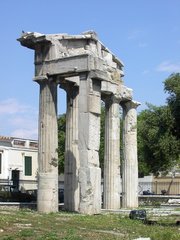Ancient Agora of Athens
|
|
Ac.agora.jpg
The Ancient Agora of Athens is the most well-known agora, located in Athens, Greece. The agora in Athens had private housing, until it was reorganized by Pisistratus in the 6th century BCE. Although he may have lived on the agora himself, he removed the other houses, closed wells, and made it the centre of Athenian government. He also built a drainage system, fountains, and a temple to the Olympian gods. Cimon later improved the agora by constructing new buildings and planting trees. In the 5th century BC there were temples constructed to Hephaestos, Zeus, and Apollo. The Areopagus and the assembly of all citizens met elsewhere in Athens, but some public meetings, such as those to discuss ostracism, were held in the agora. Beginning in the period of the radical democracy (after 509 BCE), the Boule, or city council, the Prytaneis, or presidents of the council, and the Archons, or magistrates, all met in the agora. The law courts were located there, and any citizen who happened to be in the agora when a case was being heard, could be forced to serve as a juror; the Scythian archers, a kind of mercenary police force, often wandered the agora specifically looking for jurors.
The agora in Athens again became a residential area during Roman and Byzantine times.
External links and references
- Hellenic Ministry of Culture: The Ancient Agora of Athens (http://www.culture.gr/2/21/211/21101a/e211aa03.html) - official site with a schedule of its opening hours, tickets and contact information.
- Agora Excavations (http://www.agathe.gr) - American School of Classical Studies Agora excavation project.
- Map of the Agora of Athens in Socrates and Plato's time (http://plato-dialogues.org/tools/agora.htm)

